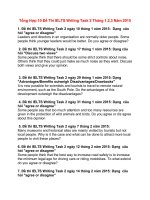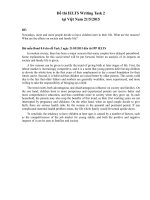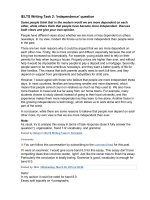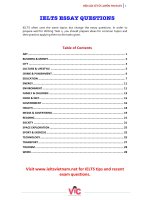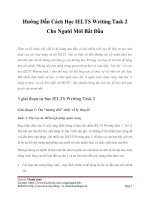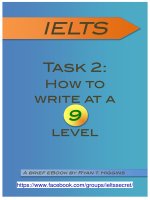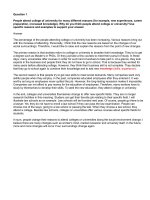IELTS writing task 2 ebook
Bạn đang xem bản rút gọn của tài liệu. Xem và tải ngay bản đầy đủ của tài liệu tại đây (1.88 MB, 52 trang )
1
1st Edition © 2017 - 2020 IELTSTutors.org
Free Books and
Apps
here
( />
IELTS Vocabulary (with Writing Task 1 and
Task 2 modules)
( />
IELTS Academic Writing Task 1
( />
IELTS Writing Task 2
( />
2
Table of Contents
How to Use this eBook ................................................................................................................. 5
1) With our Online Writing Course ..................................................................................................... 5
2) As Standalone Material................................................................................................................... 5
About the IELTS Academic Writing Task 2 Test .............................................................................. 7
Task Response ................................................................................................................................. 7
Coherence and Cohesion ................................................................................................................ 7
Lexical Resource .............................................................................................................................. 8
Grammatical Range and Accuracy .................................................................................................. 9
Band Descriptors........................................................................................................................ 11
Glossary of Important Terms ...................................................................................................... 12
Gifts for Young People | Structure .............................................................................................. 13
Model Essay .................................................................................................................................. 13
Colour key ..................................................................................................................................... 13
Notes | Structure .......................................................................................................................... 14
Status and Possessions | Relevant Ideas ..................................................................................... 17
Model Essay .................................................................................................................................. 17
Notes | Relevant Ideas.................................................................................................................. 18
Learning English | Paragraph Unity ............................................................................................. 21
Model Essay .................................................................................................................................. 21
Notes | Paragraph Unity ............................................................................................................... 22
Obesity | Linking Words and Phrases.......................................................................................... 24
Model Essay .................................................................................................................................. 24
Notes | Linking Words and Phrases .............................................................................................. 24
Parents who Work | Grammar ................................................................................................... 27
Model Essay .................................................................................................................................. 27
Notes | Grammar .......................................................................................................................... 28
International Tourism | Vocabulary ............................................................................................ 30
Model Essay .................................................................................................................................. 30
Notes | Vocabulary ....................................................................................................................... 32
Attitude in Tests | Referencing ................................................................................................... 34
Model Essay .................................................................................................................................. 34
Notes | Referencing and Substitution .......................................................................................... 35
3
Sports and Public Health | Including your Opinion ...................................................................... 37
Model Essay .................................................................................................................................. 37
Notes | Including your Opinion .................................................................................................... 38
Endangered Animals | Problem Solution Essay Structure ............................................................ 39
Model Essay .................................................................................................................................. 39
Notes | Problem Solution Essay Structure.................................................................................... 40
Violence on TV | Developing Ideas ............................................................................................. 42
Model Essay .................................................................................................................................. 42
Notes | Body Paragraph Structure................................................................................................ 43
Exploiting Animals | Essay Structure 2 ........................................................................................ 45
Model Essay .................................................................................................................................. 45
Notes | Structure .......................................................................................................................... 46
Studying Abroad | Linking Words ............................................................................................... 48
Model Essay .................................................................................................................................. 48
Notes | Linking Words and Referencing ....................................................................................... 49
Final Comments ......................................................................................................................... 52
4
HOW TO USE THIS EBOOK
1) With our Online Writing Course
( />This eBook contains example IELTS writing task 2 essays from our *online task 2 writing course. We
recommend that you use this book as a study aid while you complete the online course.
* />
The online course contains 47 lessons that cover all of the task 2 essay types. It provides in depth
exploration of the language and strategies that are introduced in this eBook as well as providing you
15% off code:
WTAC2020
with tutor support through email, Skype and our learner forums. If you do not yet have access to the
course, use the coupon code below at checkout to get 15% off.
Use the code at checkout when you purchase the course. Follow the steps below.
1. Visit the course page ( />2. Select ‘Buy Now’
3. Apply coupon code ‘WTAC2020’ to receive your discount
2) As Standalone Material
Each of the 12 tasks in this eBook comes with a model answer (we refer to the model answers as
essays). After each essay, notes explain the essay organization and structure, as well as important
aspects of the language. Studying all 12 essays and the accompanying notes provides a good
introduction to how to achieve a high band score in writing task 2.
5
To make the most of this book, we recommend that you write each essay before you read our model
answer. Follow the steps below:
1) Begin with the first task of the book.
2) Read the task very carefully. What are the key words in the task? Key words tell you
what the topic of the essay is.
3) Consider how many parts the question has. To get a good task response score, all parts
of the question must be fully answered. For example, the following question has two
parts: ‘What are the problems of… and what are the solutions?’. A roughly equal
amount of space in the essay must be spent answering both parts of the question.
Likewise, a ‘discuss both views’ task has two parts, meaning that you must spend equal
time discussing each of the two views. A task with one part, such as ‘To what extent do
you agree/disagree?’’ means that you can write a one-sided argument if you wish.
4) Spend 5 to 10 minutes brainstorming ideas and planning how to organise them so you
could write the essay yourself. As you will see, we recommend that you write 4
paragraphs. The first paragraph should introduce the topic and include a thesis
statement (a sentence which states your opinion). The second and third paragraphs
should include the main arguments of your essay. Make sure they are relevant to the
topic and question!
5) Write your essay. To improve your time management, you may wish to time yourself
(write at least 250 words in 40 minutes including planning time).
6) Compare your finished essay to our model and study our notes. Is there anything you
can learn from our notes that you could have used to make your essay better?
7) Rewrite your essay using the lessons learned from our notes.
8) Repeat this process for all of the tasks in the book.
If you follow these steps correctly, by the end of the book you will have a good understanding of
how to write a high quality task 2 essay. If you have any questions about the IELTS test or this
eBook, send an email to us as
We hope you find this book and our courses useful and we wish you good luck on your IELTS
journey!
Sam and Tom
Founders of IELTSTutors.org
6
ABOUT THE IELTS ACADEMIC WRITING TASK 2 TEST
The IELTS writing test is a 1-hour test which includes two tasks. Academic and General candidates
complete very different tasks for task 1. However, task 2 is very similar for both candidates as it
involves writing an essay.
In task 2 of the IELTS Writing test, the candidate is presented with an opinion, idea, argument or
problem, which he/she must respond to. It is important for the ideas in the essay to be logical and
well organised. The essay must be at least 250 words and should be completed in no more than 40
minutes. Learn more about the writing test on our website here.
When examiners mark a task 2 essay, they award a band score (from 1, lowest; to 9, highest) for 4
different criteria: task response, coherence and cohesion, lexical resource and grammatical range
and accuracy. Find out more about these criteria and how to achieve a good band score for each one
below.
TASK RESPONSE
Task response is a measure of how well the essay question is answered. If all parts of the question
are covered and the ideas are logical then task response will be high.
The key aspects of task response are:
Length - You must write a minimum of 250 words in 40 minutes. Writing below this may cause you
to lose marks for task response.
Topic introduction - The first sentence of your essay should be a good quality paraphrase of the task
2 topic.
Position – A good writer makes his/her position (opinion) clear throughout the essay. Make sure
that if the examiner only reads your introduction and conclusion, he/she knows exactly what your
position is regarding the question. Not doing so makes it unlikely for you to reach a band 7.
Quality of main ideas - Each paragraph should begin with a main idea or argument, followed by
supporting details. Are your main ideas easy to understand and relevant to the task? If they are not
relevant you will not get above a band 5 for task response.
Support for ideas - Each paragraph should begin with a main idea or argument, followed by
supporting details. Do you support your main ideas with clear explanations, examples and/or
reasons?
COHERENCE AND COHESION
A coherent essay is one that is logical and well organised. Cohesion refers to the accurate use of
grammar and vocabulary to link information. Correct use of linking words and reference words
increase cohesion.
The key aspects of coherence and cohesion are:
7
Thesis statement - A thesis statement is usually the final sentence of the introduction. It should
make your position clear regarding the question. A good thesis statement should also suggest how
the essay is organized.
Here is an example: 'I believe that the issue of obesity should be tackled by introducing a sugar tax on
unhealthy food and by improving health education in schools.' This thesis statement indicates that
body paragraph 1 (the next paragraph) will argue for a sugar tax and body paragraph 2 will argue for
improving health education in schools.
Topic sentences - Topic sentences state the main idea or argument of a paragraph. The topic
sentence should be the first sentence of the paragraph.
Progression of ideas - In good writing, ideas should be logical and flow smoothly. Do your ideas
progress naturally and clearly from one to the next, or do they feel disconnected?
Linking ideas - Do you use a variety of words and phrases to link your ideas (i.e. 'however',
'secondly', 'furthermore', 'for instance').
Referencing and substitution - To avoid repetition of nouns we use referencing, such as 'he', 'this',
'it', and substitution, such as 'these ideas', 'such people’.
Paragraph unity – Each paragraph must have a clear purpose (to express a main idea/argument)
that is separate from the other paragraphs. Is this true of your writing?
Within each paragraph, are all the sentences connected to the purpose of that paragraph?
Here is an example paragraph that has a sentence that does not logically fit it:
'Advertising can have a number of harmful effects (topic sentence). Firstly, the way adverts depict
the life of others can make viewers feel insecure about themselves (first support). For instance, when
we see a beautiful couple on TV selling a new range of clothes, we may wonder why we are not as
beautiful, or why we have not found similar love (example of support). Repeated viewing is likely to
have a negative impact on our mental health (consequence of support). Students should be taught
more about mental health in schools (disconnected sentence - not about advertising - that should
not be in the paragraph). Secondly... (second support)... etc.'
Conclusion - The conclusion should begin with a signal ('In conclusion,'). The conclusion should
summarise the main arguments of your essay. You can finish the essay with a final comment
(typically a warning, suggestion or a prediction). Here is a shortened example: 'In conclusion (signal),
although *** can be useful (one argument), I believe that *** is better (my position) because....
(strongest argument). To move forward, we should... (suggestion)'
LEXICAL RESOURCE
This refers to your use of vocabulary. The wider the range of vocabulary you use to accurately
express yourself, then the higher your band score will be. Spelling and word formation are also
important for a good lexical resource score.
8
The key aspects of lexical resource are:
Academic register - Use formal language which is suitable for essay writing (i.e. use academic
vocabulary when possible, avoid contractions such as 'don't', and avoid a conversational, informal
tone such as 'there is a lot of stuff that has got to get better' ).
Precision - Use the appropriate vocabulary to clearly express your ideas.
For example, ‘In recent years there has been a rise in the number of people buying cars’ (‘a rise’ does
not give much detail). This sentence could be improved using more precise language. For example,
‘In recent years there has been a significant and sustained rise in the number of people buying cars’
(‘a significant and sustained rise’ contains much more detail and is therefore a more precise use of
vocabulary.
Range - Do you have a wide vocabulary or do you often repeat the same words? In general, try to
avoid repeating the same word in the same sentence or group of sentences.
Word formation – As with people, words have families. Different forms of words (verb, noun,
adjective) in the same family are formed and spelt differently. You need to choose the correct form
of each word and consider how it is spelt (for example, 'People are always interested in stories'
rather than 'People are always interesting in stories').
Collocation - Collocations are pairs of words that are found together. For example, 'I am preparing
for an exam' is a correct verb preposition collocation while 'I am preparing at an exam' is an
incorrect collocation. Do you use the correct collocations?
Spelling - Do you make many spelling mistakes?
GRAMMATICAL RANGE AND ACCURACY
Grammatical range is high if you use a wide variety of different grammatical structures and sentence
types. Try to use a range of simple, compound and complex sentences. Grammatical accuracy is high
if you make few grammar mistakes.
The key aspects of grammatical range and accuracy are:
Range of structures - Use a number different complex sentence types. A complex sentence must
include at least one independent clause and one dependent clause. Some useful types of complex
structures are conditionals, relative clauses, time clauses, noun clauses and contrast clauses. In your
writing, do you use different complex structures?
Overall Accuracy – Good writing is grammatically accurate. How frequently do you make
grammatical mistakes and do they make your writing difficult to understand?
Verb accuracy – Do you use verb tense effectively? Do you know when to use gerunds and
infinitives?
Noun accuracy – Can you accurately form noun and complex noun phrases? Many IELTS candidates
make errors with plural and singular nouns as well as with articles (‘a’,’an’ & ‘the’). Can you add
9
more information to a noun using prepositional phrases and relative clauses in order to form
complex nouns?
Punctuation - Do you use punctuation (capitals, commas & full stops) accurately? Be especially
careful when using punctuation in long sentences that contain a number of clauses.
Study the marking criteria for the different bands by looking at the band descriptors on the following
page.
If you would like a tutor to mark your reports and give you a detailed breakdown of
your level based on these criteria, you can order writing feedback on our website.
( />
10
BAND DESCRIPTORS
Response
11
GLOSSARY OF IMPORTANT TERMS
This is a small collection of important words and phrases that we use frequently in this book and
when teaching. Make sure you are familiar with these terms before reading our task notes.
Body Paragraph
The paragraphs, usually 2, which contain the main arguments in
your essay. The introduction paragraph is not a body paragraph.
Collocation
Two words that are often used together. For example, account for
& higher education.
Clause
A group of words that contains a verb and usually a subject. A
clause may be a whole sentence or a part of a sentence.
Independent Clause
A clause containing at least a subject and a verb. An independent
clause can stand alone as a sentence. For example: Most of them
were satisfied.
Dependent Clause
A group of words usually containing a subject and a verb but
which does not express a complete thought and so cannot stand
alone as a sentence. For example: When people were questioned,
most of them were satisfied. When people were questioned is a
dependent time clause and it must accompany an independent
clause. If the dependent clause precedes the independent clause
then the two are separate by a comma.
Complex noun phrase
A noun that is followed by extra information in the form of a
relative clause, prepositional phrase or other structure (for
example, the vast majority of people who visited – majority is the
head noun and more information is provided about it with the
prepositional phrase of people and the relative clause who
visited).
Paraphrase
A paraphrase is when a message is retold using different
vocabulary and/or grammar. For example, The number of
homeowners rose significantly / There was a dramatic increase in
the amount of people who owned homes. The second sentence
paraphrases the first, meaning it presents exactly the same
meaning as the first, but with different vocabulary and grammar.
Phrase
A small group of words standing together as a conceptual unit.
They typically form a part of a clause (for example: Most of them
were satisfied. This sentence is formed of the noun phrase Most of
them and the verb phrase were satisfied).
Topic Sentence
Usually placed at the beginning of a body paragraph. A sentence
that tells the reader the topic of the paragraph.
12
GIFTS FOR YOUNG PEOPLE | STRUCTURE
Study this task in our online course: Module 2 – Opinion Essays, ‘Structuring the Essay’
Some people think that money is the best gift to give to young people
while others think other types of gifts are better for young people.
Discuss both views and give your opinion.
(Our notes: Make sure you discuss both views, not just the view that you agree with)
MODEL ESSAY
It can be a struggle to select an appropriate gift for a young relative or the child of a friend. While
some believe that money is the best type of gift, I agree with those who suggest other gifts are more
suitable.
Many people believe that money makes an excellent present. Proponents of this view may suggest
that young people already have what they need in terms of toys and gadgets and so giving them
more will not be of benefit. They also argue that the young may actually learn valuable skills from the
process of choosing to save or spend their money. For example, if the young person chooses to spend
the money, they will learn the value of things that they wish to buy and what they can or cannot
afford. This could make them more financially mature and independent.
On the other hand, I am in agreement with those who believe that actual gifts are better than
money. An important reason is that money is quite an impersonal gift since it shows no
understanding of the interests of the receiver. It is therefore more appropriate to give something that
shows the adult understands the desires of the young person, such as a piece of jewelry or the shirt of
his/her favourite sports club. Furthermore, an educational gift, such as a book, or a useful gift, such
as a watch, allows the young person to develop or improve his/her skills and so is directly beneficial.
In conclusion, whereas many believe that financial gifts may increase independence and be popular, I
side with those who suggest gifts showing an understanding of the young person or which are
educational are more beneficial. It is clearly important to consider the needs and interests of young
people when selecting gifts. (298 words)
COLOUR KEY
Topic Introduction
Thesis Statement
13
Topic Sentences (outline the topic of the paragraph)
Conclusion Signal
Summary of Arguments
NOTES | STRUCTURE
This essay is very well structured and would receive a band 9 in the IELTS test. Below is an analysis of
the structure of the essay.
The first thing we notice is that there are 4 paragraphs:
Paragraph 1
The introduction paragraph includes a sentence that introduces the topic and the thesis statement.
The thesis statement has two purposes. Firstly, it presents the writer’s opinion regarding the essay
question, and secondly, it outlines the arguments in the following paragraphs.
Here the thesis statement is: ‘While some believe that money is the best type of gift, I agree with
those who suggest other gifts are more suitable.’
From this, it is clear that the writer thinks that money is not the best gift and that he/she will first
present a counter argument (the belief that ‘money is the best type of gift’), and then present the
main argument (that ‘other gifts are more suitable’).
This is a great way of using the thesis statement to organize the order of the essay.
Paragraph 1: It can be a struggle to select an appropriate gift for a young relative or the child of a
friend. While some believe that money is the best type of gift, I agree with those who suggest other
gifts are more suitable.
Paragraph 2
This is the first body (or argument) paragraph, which presents a counter argument (an argument
which the writer disagrees with).
Paragraph 2 begins with a topic sentence. This sentence tells the reader what this paragraph is
about. From this topic sentence, we know that the paragraph will explain why ‘people believe that
money makes an excellent present.’
14
The writer introduces the details which support the topic sentence with the phrase ‘Proponents of
this view may suggest…’. ‘Proponents’ are ‘people who support (an idea)’. This cleverly shows that
these supporting details are not the opinions of the writer.
The sentences following the topic sentence provide reasons and examples which support the topic
sentence. The paragraph finishes with a possible positive consequence of giving money as a gift.
Paragraph 2: Many people believe that money makes an excellent present. Proponents of this view
may suggest that young people already have what they need in terms of toys and gadgets and so
giving them more will not be of benefit. They also argue that the young may actually learn valuable
skills from the process of choosing to save or spend their money. For example, if the young person
chooses to spend the money, they will learn the value of things that they wish to buy and what they
can or cannot afford. This could make them more financially mature and independent.
Paragraph 3
This is the second body (or argument) paragraph, containing the writer’s main argument.
Paragraph 3 also begins with a topic sentence, so that we know it will argue that ‘actual gifts are
better than money.’
The paragraph then explains the reasons behind this and gives examples of gifts and their benefits.
Paragraph 3: On the other hand, I am in agreement with those who believe that actual gifts are
better than money. An important reason is that money is quite an impersonal gift since it shows no
understanding of the interests of the receiver. It is therefore more appropriate to give something that
shows the adult understands the desires of the young person, such as a piece of jewelry or the shirt of
his/her favourite sports club. Furthermore, an educational gift, such as a book, or a useful gift, such
as a watch, allows the young person to develop or improve his/her skills and so is directly beneficial.
Paragraph 4
Paragraph 4 is the conclusion paragraph.
This paragraph starts with a conclusion signal ‘In conclusion,…’ to inform the reader that this is the
final paragraph and summarises the main arguments found in the essay.
The summary of the arguments is in red, and also includes the writers position (his/her opinion).
The essay finishes with a piece of advice that is connected to the topic. Other finishing sentences
could include a warning, a suggestion or a prediction.
Paragraph 4: In conclusion, whereas many believe that financial gifts may increase independence
and be popular, I side with those who suggest gifts showing an understanding of the young person or
15
which are educational are more beneficial. It is clearly important to consider the needs and interests
of young people when selecting gifts.
Vocabulary note: I side with… = I agree with…
Note that it is important to include your opinion both in the thesis statement in the introduction and
in the summary sentence in the conclusion.
16
STATUS AND POSSESSIONS | RELEVANT IDEAS
Study this task in our online course: Module 2 – Opinion Essays, ‘Generating Ideas’
A person’s worth nowadays seems to be judged according to social status
and material possessions. Old-fashioned values, such as honour, kindness
and trust, no longer seem important.
To what extent do you agree or disagree with this opinion?
(Our note: Both sentences are presented as opinions, so you should discuss both social status and
material possessions, as well as old fashioned values. You could agree with the statement, disagree
with the statement or have a balanced opinion (both agreeing and disagreeing) with the statement.)
MODEL ESSAY
Status and money are highly valued in today’s society and have certainly changed our values to some
extent. However, in everyday life I don’t believe a person’s worth is judged that differently compared
to in the past.
It is apparent that most celebrities today are admired or envied solely for their material wealth or
position in various social hierarchies. Many of these people are known to turn their backs on friends,
cheat on their spouses or spend their evenings over-indulging in alcohol and/or drugs. Things like
owning a mansion, driving an expensive car and getting into A-list parties are exalted above oldfashioned values. Ultimately, though, it is the many readers of gossip magazines and celebrity blogs
who reinforce these ideas.
Nevertheless, I do believe that in their day-to-day lives most people still believe in values such as
honour, kindness and trust. In some way most of us want to form loving families, raise our children to
be good citizens, stand up for the downtrodden and protect our communities from harm. We still
form friendships, romances and business partnerships based on old-fashioned criteria. For example,
when our trust is abused or we are unfairly treated, we see that as a major violation of our
relationship and we judge the wrongdoer accordingly.
In conclusion, while status and possessions as a measure of a person’s worth have become more
popular, the behavior of most ordinary people shows that the old values are still strong. It is unlikely
that honour, kindness, and trust will ever be replaced while parents continue to teach their children
to respect them. (263 words)
17
NOTES | RELEVANT IDEAS
For this task we will look at the relevance of ideas. When you generate arguments, it is important
that they are directly connected to the task. This task asks you to discuss whether status and
possessions rather than personal qualities such as kindness are more highly respected in today’s
society. Thus, our arguments should be based on evidence that supports these ideas.
In the model answer, the writer first presents evidence that some rich and famous people seem
materialistic, which directly supports the ‘status and possessions’ argument. The writer uses this as a
counter argument to his main argument which is that people still care more about traditional
personal qualities. This is supported by examples of the way in which most societies and people
function (‘most of us want to form loving families’). Both arguments together address all parts of the
task in a relevant and meaningful way. However, notice that the writer presents his strongest
argument in the second body paragraph. This is a common convention of academic writing in
English.
If you are finding it difficult to think of arguments, it helps to look at the topic from different
perspectives. Here are some examples:
The perspective of the individual: What evidence is there that individual people are materialistic?
The perspective of the culture/society: What evidence is there that society is materialistic?
The perspective of the environment: Does the way we treat the environment suggest that we are
materialistic and have lost kindness?
The perspective of economics: Does the way we think about money and growth suggest we are
materialistic and have lost kindness?
Some of these perspectives may be easily applied to the task, and some might be more difficult, but
thinking in this way will help you grow ideas.
Here are the main perspectives you may consider when planning:
Individual
Cultural/societal
Environmental
Economic
Technological
Political
Education Related
Health Related
18
Here is an example of a task that can be looked at from different perspectives:
Social Media has become a very popular way for people to communicate.
Is this a positive or a negative development?
Let’s look at it from different perspectives. Think of your own ideas first, then compare them to ours.
Individual
People can effortlessly send messages or talk to any of their friends or colleagues.
People may feel envy or jealousy if they see others on social media with seemingly perfect lives.
Cultural/societal
Countries will be more connected as distant communication is very easy.
People may choose to socialize in real life less frequently, leading to an increase in loneliness across
society.
Environmental
If people can socialize online, they may choose to do so rather than travelling somewhere, saving
pollution from vehicle exhausts.
Building and running the phones, computers and servers needed for social media can damage the
environment.
Economic
The popularity of social media has led to the growth of huge tech companies that employ thousands
of people.
These multinational companies often pay very little tax on their income.
Technological
Due to the success of social media, it is important to keep researching newer technology to improve
our phones, computers, servers, connection speeds etc. which can help other online and technology
based sectors.
Political
Social media is sometimes used to influence our ideas about politics. This has helped create ‘fake
news’.
19
Education Related
Social media can be a useful source of information if we can separate what is true from what is fake.
Social media has led to online bullying.
Health Related
Sitting down and looking at a screen for hours a day can damage our posture and our eyes.
No enough face-to-face interaction may cause anxiety.
Notice how we can think of a great variety of ideas by thinking of different perspectives. Remember
that we shouldn’t include too many ideas in our essay because then we will not have time to
develop them all. Instead, you should choose 2 of your favourite arguments / perspectives to write
about (one body paragraph per argument/perspective). After you have chosen your main
arguments, remember to support them with explanations and/or examples.
Next time you are planning an essay, try thinking about the topic from a number of these
perspectives and see if they help you to generate interesting ideas.
20
LEARNING ENGLISH | PARAGRAPH UNITY
Studying the English language in an English speaking country is the best
but not the only way to learn the language.
To what extent do you agree or disagree?
MODEL ESSAY
These days, there are many effective ways to learn a foreign language. It is clear that a student can
learn English to a high level in his/her home country; however, studying in an English speaking
country can lead to faster language learning due to immersion in the culture.
These days, students in non-English-speaking countries commonly learn English to an acceptable
level in high schools and universities in their own countries. Although their spoken English may not be
that accurate or fluent, their knowledge of grammar is often quite good, which is extremely
important when students come to an English speaking country to try and perfect their use of the
language. In addition to this, studying the basics of English at secondary school in one’s home
country is less stressful than learning the language while overseas. This is because students living at
home do not have the anxiety caused by problems such as finding accommodation, financing a
foreign trip and trying to survive in a foreign country where day to day living away from support
networks of friends and family may cause stress.
On the other hand, there are several obvious advantages to learning English in English speaking
countries. Every day there are frequent chances to practice listening to and speaking with native
speakers, which leads to faster learning. If a student chooses to live with a local host family which
does not speak her first language, she can immerse himself in the language and experience the
culture first-hand, helping to improve fluency. Furthermore, if students attend an English language
school full-time, the teachers will be native speakers. In this case, not only do the student’s speaking
and listening skills improve, but attention can be given to developing reading and writing skills as
well.
In conclusion, even though it is clearly desirable to study English in an English-speaking country, a
reasonable level of English can be achieved at home if a student is hardworking and motivated to
improve. Hopefully in the future, more students will have the opportunity to study languages abroad.
(341 words)
21
NOTES | PARAGRAPH UNITY
What is paragraph unity? If a body paragraph has unity, all of the sentences in the paragraph
support and expand on the topic sentence. This means that there should be no sentences in a
paragraph that are not connected to the topic of that paragraph. This can be demonstrated with this
sample essay.
This essay has two body paragraphs. We can see a topic sentence at the beginning of each one.
Body paragraph 1: These days, students in non-English speaking countries commonly learn English to
an acceptable level in high schools and universities in their own countries. Although their spoken
English may not be that accurate or fluent, their knowledge of grammar is often quite good, which is
extremely important when students come to an English speaking country to try and perfect their use
of the language. In addition to this, studying the basics of English at secondary school in one’s home
country is less stressful than learning the language while overseas. This is because students living at
home do not have the anxiety caused by problems such as finding accommodation, financing a
foreign trip and trying to survive in a foreign country where day to day living away from support
networks of friends and family may cause stress.
The first topic sentence is ‘These days, students in non-English-speaking countries commonly learn
English to an acceptable level in high schools and universities in their own countries.’ This tells the
reader that this paragraph discusses learning English in a student’s home country. The paragraph
explains what ‘acceptable level’ means (using knowledge of grammar as an example) and adds an
argument that studying in your own country is less stressful. These ideas are all connected to the
topic sentence and there are no sentences or ideas that do not belong.
Body paragraph 2: On the other hand, there are several obvious advantages to learning English in
English speaking countries. Every day there are frequent chances to practice listening to and
speaking with native speakers, which leads to faster learning. If a student chooses to live with a local
host family which does not speak his first language, he can immerse himself in the language and
experience the culture first-hand, helping to improve fluency. Furthermore, if students attend an
English language school full-time, the teachers will be native speakers. In this case, not only do the
student’s speaking and listening skills improve, but attention can be given to developing reading and
writing skills as well.
The topic sentence informs us that the topic of this paragraph is related to ‘several obvious
advantages to learning English in English speaking countries‘. The paragraph then describes these
advantages with examples that are all connected to the topic.
22
Both body paragraphs have unity and contain arguments that are fully developed. When you write
academic essays, make sure that the body paragraphs have unity and that all of the ideas which you
present are relevant to the topic.
23
OBESITY | LINKING WORDS AND PHRASES
Study this task in our online course: Module 4 – Problem Solution Essays, ‘Vocabulary in Context 1’
Obesity is a serious problem in many countries, especially in rich countries.
What causes obesity and how can it be solved?
MODEL ESSAY
With the advent of urbanisation and the rise in popularity of fast food, there have been
accompanying issues with rising obesity rates, especially in developed countries such as the UK and
the USA. It is clear that obesity rates are higher in developed countries because their citizens are
wealthier; however, there are a number of ways in which the obesity epidemic can be ameliorated.
To begin with, it should be unsurprising that fast food is incredibly popular in wealthy countries. Due
to the high levels of development in these countries, consumers possess more money and can
therefore consume vast amounts of fast food without seriously diminishing their income. For
example, the American Dietary Association found that compared to the average Indian household,
the average American household has a six times larger budget for food per month. Consequently, it
is to be expected that obesity rates are much higher in countries with larger amounts of wealth.
However, despite the severity of the obesity problem, there are a number of ways in which
developed countries could battle it more effectively. Firstly, developed governments could put far
more pressure on fast food outlets to provide healthy alternatives to hamburgers, French fries and
soft drinks. Secondly, public exercise initiatives could be advertised and promoted far more
vigorously. Lastly, modules that inform teenagers about healthy dietary requirements could be
taught at schools.
In conclusion, although obesity is a serious issue in the developed world, if we can make fast food
companies accountable for damage to health and promote exercise, the situation will surely improve
in the coming years. (263 words)
NOTES | LINKING WORDS AND PHRASES
In the model essay above, the words and phrases which link or introduce ideas have been
highlighted. These are very useful tools to make your essays flow smoothly and give you a high
coherence and cohesion band score.
The function of each linking word/phrase is discussed below.
24
With the advent of urbanisation and the rise in popularity of fast food, there have been
accompanying issues with rising obesity rates, especially in developed countries such as the UK and
the USA. It is clear that obesity rates are higher in developed countries because their citizens are
wealthier; however, there are a number of ways in which the obesity epidemic can be ameliorated.
especially – used to highlight the high relevance or importance of the following countries.
a number of ways– this informs the reader that there will be more than one solution offered to the
obesity problem.
To begin with, it should be unsurprising that fast food is incredibly popular in wealthy countries. Due
to the high levels of development in these countries, consumers possess more money and can
therefore consume vast amounts of fast food without seriously diminishing their income. For
example, the American Dietary Association found that compared to the average Indian household,
the average American household has a six times larger budget for food per month. Consequently, it
is to be expected that obesity rates are much higher in countries with larger amounts of wealth.
To begin with – this phrase introduces the first argument.
Due to – this is a useful phrase to introduce a cause. It is always followed by a noun or noun phrase
and a comma.
therefore – this word introduces the result of a previously mentioned cause.
For example – this common phrase introduces an example. Alternative phrases you can use are ‘for
instance’, ‘one example is’ and ‘this can be seen in/by/with’.
Consequently, it is to be expected that – this phrase introduces a result and informs the reader that
the following statement is a likely (expected) outcome.
However, despite the severity of the obesity problem, there are a number of ways in which
developed countries could battle it more effectively. Firstly, developed governments could put far
more pressure on fast food outlets to provide healthy alternatives to hamburgers, French fries and
soft drinks. Secondly, public exercise initiatives could be advertised and promoted far more
vigorously. Lastly, modules that inform teenagers about healthy dietary requirements could be
taught at schools.
However – when it is used at the beginning of a paragraph, ‘however’ is a signal that the paragraph
will offer a counter argument to the argument in the paragraph before.
despite – this introduces a contrast which links the negative obesity issue with the positive possible
solutions.
Firstly, Secondly, Lastly – these words are used to sequence or organise a list of ideas or the steps of
a process.
25
